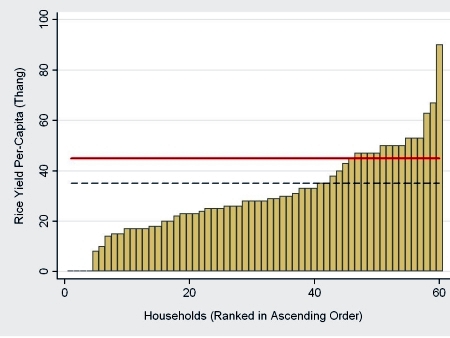Discussions of rural life in Thailand often proceed in the absence of good quality local information. This is unfortunate, as local studies often throw up findings that challenge popular misconceptions. Here is a fascinating graph from ANU PhD researcher Runako Samata.
Runako has been studying the economy of upland Karen farmers in Thailand’s Mae Hong Son province. As I have discussed previously on New Mandala, Karen upland farmers feature prominently in the local sufficiency/local wisdom account of NGOs and activist academics. These accounts are often motivated by a legitimate desire to defend upland farming practices from exaggerated charges of environmental degradation. But they sometimes tend to slip over into a romanticisation of upland livelihoods. This is where Runako’s graph comes in useful. The graph illustrates the annual per capita un-milled rice production for 60 households that are entirely dependant on upland fields (not irrigated paddy) for their rice. The two lines indicate two locally informed estimates of annual per capita rice requirement (one thang is about 10 kilograms). The story it tells is stark: the vast majority of these upland rice farmers cannot meet their rice requirements!
Runako has found that farmers respond to this deficiency in various ways – some diversify into cash crops (interestingly she found that some of the highest upland rice yields were achieved by farmers who had grown cabbages on the plots in the previous year – the rice benefits from the fertiliser residue) while many others seek wage labour opportunities within the village, in the local trading centre or in towns and cities further afield. As in much of rural Thailand, achieving sufficiency involves spatially dispersed diversity.
 Facebook
Facebook  Twitter
Twitter  Soundcloud
Soundcloud  Youtube
Youtube  Rss
Rss 
